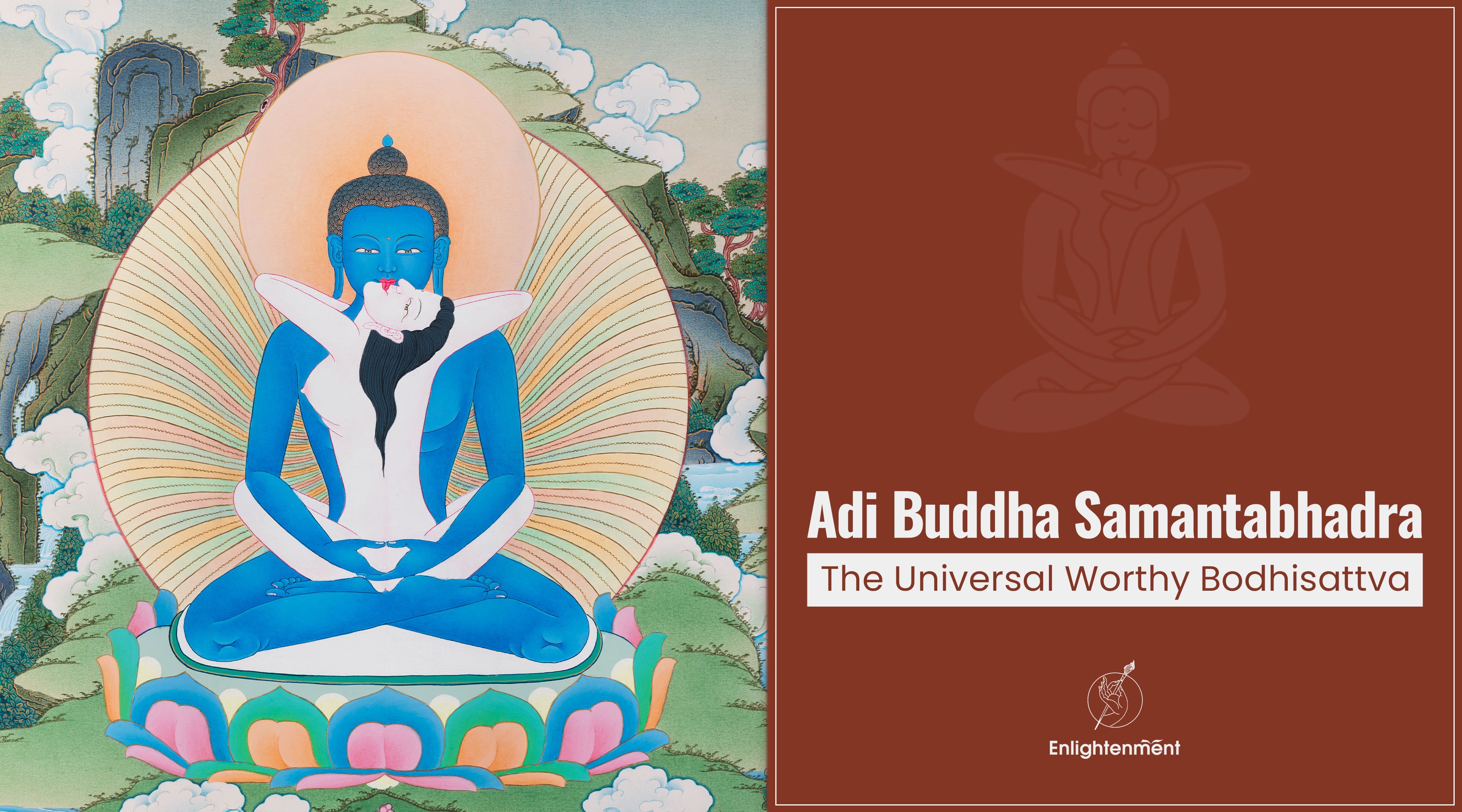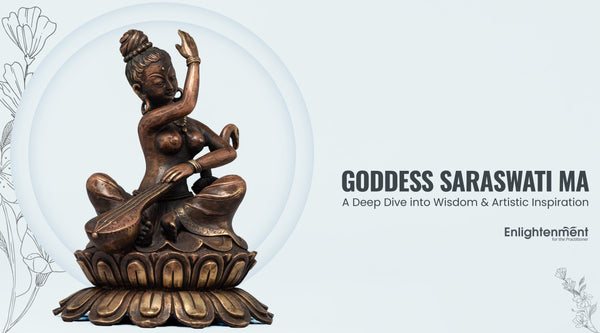Adi Buddha Samantabhadra: The Universal Worthy Bodhisattva
Within the domain of Mahayana Buddhism, Samantabhadra, also recognized as Universal Worthy or Puxian in Chinese Buddhism, commands profound reverence. This Bodhisattva personifies the utmost virtues and symbolizes the universal yearning for enlightenment and the welfare of all sentient beings.
Key Takeaways
- Samantabhadra, or Universal Worthy, is a revered bodhisattva in Mahayana Buddhism.
- He embodies the bodhisattva ideal of compassion, wisdom, and the aspiration for the enlightenment and well-being of all beings.
- Samantabhadra's iconography includes riding on an elephant, holding symbolic objects, and representing the highest virtues.
- His teachings focus on the Ten Great Vows and meditation and mindfulness.
- Samantabhadra is revered in various Buddhist traditions, including Chinese, Korean, and Japanese Buddhism.
Samantabhadra, meaning "Universal Worthy" or "All-Pervading Goodness," stands out as a revered bodhisattva dedicated to the well-being and enlightenment of all sentient beings. A prominent figure in Mahayana Buddhism, he is closely linked with the Avatamsaka Sutra, also recognized as the Flower Garland Sutra, elucidating reality's expansive and interconnected essence.
Unbound by specific temporal or spatial constraints, Samantabhadra exists as a transcendent and timeless being, ever prepared to aid those on the path to enlightenment. His profound compassion and wisdom render him a crucial presence in the spiritual journey of Mahayana practitioners, embodying an unwavering commitment to the welfare of all sentient beings.
Samantabhadra's Role in Mahayana Buddhism
Click here to view to Samantabhadra Thangka
The Bodhisattva Ideal
Samantabhadra epitomizes the core bodhisattva ideal, emphasizing the cultivation of compassion, wisdom, and altruism. His purpose is to assist all sentient beings on their journey to enlightenment, serving as a model for practitioners to emulate and inspiring them to dedicate themselves to the well-being of others.
The 10 Great Samantabhadra Vows
Samantabhadra's ten great vows encapsulate the fundamental principles of his bodhisattva practice. These commitments include saving all sentient beings, practicing virtues, cultivating wisdom, and dedicating the merits of one's actions to benefit all.
Derived from the "Avatamsaka Sutra", also known as the "Flower Garland Sutra", these vows provide practitioners with a guide to align their intentions and actions with the bodhisattva path. They articulate the profound commitment of Bodhisattva Samantabhadra towards achieving Buddhahood for the benefit of all sentient beings.
-
Worship and Respect for all Buddhas:
This vow underscores the Bodhisattva's profound reverence for all awakened beings, acknowledging the diversity of Buddhas and their teachings. It emphasizes a humble and grateful attitude towards the enlightened who guide the path to liberation. -
Praises to the Buddhas:
This vow involves expressing admiration and adoration for the qualities and virtues of Buddhas, emphasizing the importance of cultivating a positive and appreciative mindset. It highlights acknowledging and celebrating the extraordinary attributes of enlightenment embodied by the Buddhas. -
Repentance and Reform of Karmic Hindrances:
Samantabhadra's vow to repent and reform emphasizes recognizing past errors and committing to purify one's karma. It sets an example of self-awareness, responsibility, and the transformative power of sincere repentance. -
Rejoicing in Others' Virtues and Merits:
This vow encourages the Bodhisattva to take joy in the virtuous actions and merits of others, promoting a selfless mindset where happiness is found in the well-being and accomplishments of fellow beings. It fosters interconnectedness and shared spiritual progress. -
Requesting the Buddhas to Continue Teaching:
Samantabhadra expresses the importance of ongoing guidance and instruction from the Buddhas, reflecting the understanding that their teachings are an inexhaustible source of wisdom and compassion essential for the enlightenment of all beings. -
Requesting the Buddhas to Remain in the World:
The Bodhisattva's plea for Buddhas to remain in the world highlights a compassionate wish for the continuous presence of enlightened beings, guiding and inspiring sentient beings. It reflects a commitment to alleviating suffering and assisting others in awakening. -
Following the Teachings of the Buddhas at All Times:
This vow emphasizes the Bodhisattva's dedication to consistently embodying and living by the Buddha's teachings. It underscores the importance of integrating the principles of compassion, wisdom, and ethical conduct into daily life, inspiring others. -
Accommodating and Benefiting All Living Beings:
Samantabhadra's vow to accommodate and benefit all beings encapsulates the core Bodhisattva ideal, expressing a commitment to inclusivity and the well-being of every sentient without discrimination. It embodies the aspiration to relieve the suffering of all beings and guide them toward enlightenment. -
Transferring All Merits and Virtues to Others:
The Bodhisattva's dedication to transferring merits signifies the selfless intention to share the positive outcomes of virtuous actions with all beings. It reflects the Mahayana principle that spiritual progress is dedicated to the welfare and enlightenment of others, not for personal gain. -
Dedicating Oneself Entirely to Enlightenment:
The final vow represents the culmination of Samantabhadra's aspirations, expressing an unwavering commitment to the ultimate goal of Buddhahood. It signifies the Bodhisattva's complete dedication to the path of enlightenment for the benefit of all sentient beings, embodying the selfless spirit of the Mahayana tradition.
In-Depth Physical Attributes and Iconography of Samantabhadra
Click here to view our Samantabhadra Wooden Artwork
The depiction of Samantabhadra, the Universal Worthy Bodhisattva, in Buddhist iconography carries profound symbolism, reflecting his role as an embodiment of wisdom and compassion. Let's explore in-depth the physical attributes and iconography associated with Samantabhadra:
Physical Attributes
- The Serene Countenance
Samantabhadra is commonly portrayed with a serene and compassionate expression, mirroring his steadfast dedication to the well-being of all sentient beings. His calm and wise visage serves as an inspiration for practitioners embarking on their spiritual journey.
- Riding on a White Elephant
A distinctive feature of Samantabhadra's iconography is his connection with a white elephant. He is frequently depicted seated atop this majestic creature, symbolizing his boundless wisdom, strength, and purity. The elephant embodies the formidable power of enlightenment, capable of overcoming the obstacles and ignorance of samsara.
Symbolic Elements
- The Four Arms: Samantabhadra is typically represented with four arms, each holding objects imbued with profound symbolism:
- A lotus flower: Symbolizing the purity of enlightenment emerging from the muddy waters of samsara, the lotus signifies the potential for spiritual awakening amid the challenges of worldly existence.
- A wish-fulfilling jewel: This jewel represents the fulfillment of wishes and the abundance of spiritual treasures, showcasing Samantabhadra's capacity to fulfill the aspirations of sentient beings and bestow blessings upon them.
- A dharma wheel: Representing the turning of the wheel of dharma, the dharma wheel symbolizes the teachings of Buddhism. It signifies the spread of wisdom and compassion, illustrating Samantabhadra's role in disseminating the path to enlightenment.
- A conch shell: Associated with the proclamation of the dharma, the conch shell, when blown, symbolizes the dissemination of teachings, calling sentient beings to the path of wisdom and compassion.
Bodhisattva Attire
The Bodhisattva Attire Samantabhadra is commonly depicted in the traditional attire of a bodhisattva adorned with robes and accessories. His attire symbolizes his dedication to the Bodhisattva ideal—a commitment to the welfare and enlightenment of all beings. It underscores his role as a compassionate guide and exemplar for practitioners.
Samantabhadra & Samantabhadri: Their Sacred Union
Click here to view our Samantabhadra Statue
In specific interpretations of Mahayana Buddhism, Samantabhadra is not depicted in isolation but is accompanied by a female counterpart known as Samantabhadri or "Universal Worthy Mother." This pairing symbolizes the harmonious integration of wisdom and compassion, the yin and yang, within the Mahayana path. This sacred partnership emphasizes several vital aspects:
- Balance of Energies: Samantabhadra represents the masculine aspect of wisdom, while Samantabhadri embodies the feminine aspect of compassion. Their union illustrates the harmonious balance of these energies, underscoring the essential nature of both qualities on the path to enlightenment.
- Completeness: Analogous to a bird requiring both wings to fly, the union of Samantabhadra and Samantabhadri signifies the completeness of the spiritual journey. It stresses that wisdom without compassion and compassion without wisdom are both incomplete.
- Harmony in Practice: The sacred union inspires practitioners to harmonize wisdom and compassion in their spiritual endeavors. It encourages individuals to cultivate both aspects in their pursuit of enlightenment.
- Unity of Opposites: The union transcends dualities and opposites, highlighting the ultimate truth that wisdom and compassion, though seemingly distinct, are intrinsically interconnected and inseparable.
- Wholeness and Integration: Samantabhadra and Samantabhadri symbolize the wholeness and integration of all dualities and dichotomies, leading to a profound understanding of ultimate reality.
Samantabhadra, the Universal Worthy Bodhisattva, is a beacon of compassion, wisdom, and selfless dedication in Mahayana Buddhism. His teachings, symbolized by the ten great vows and embodied through his iconography, inspire practitioners to cultivate these virtues and tirelessly work for the enlightenment and well-being of all sentient beings.
Across various Buddhist traditions, Samantabhadra's presence is a source of inspiration, reminding us of the boundless potential for spiritual growth and the profound significance of compassion and wisdom in our lives.


